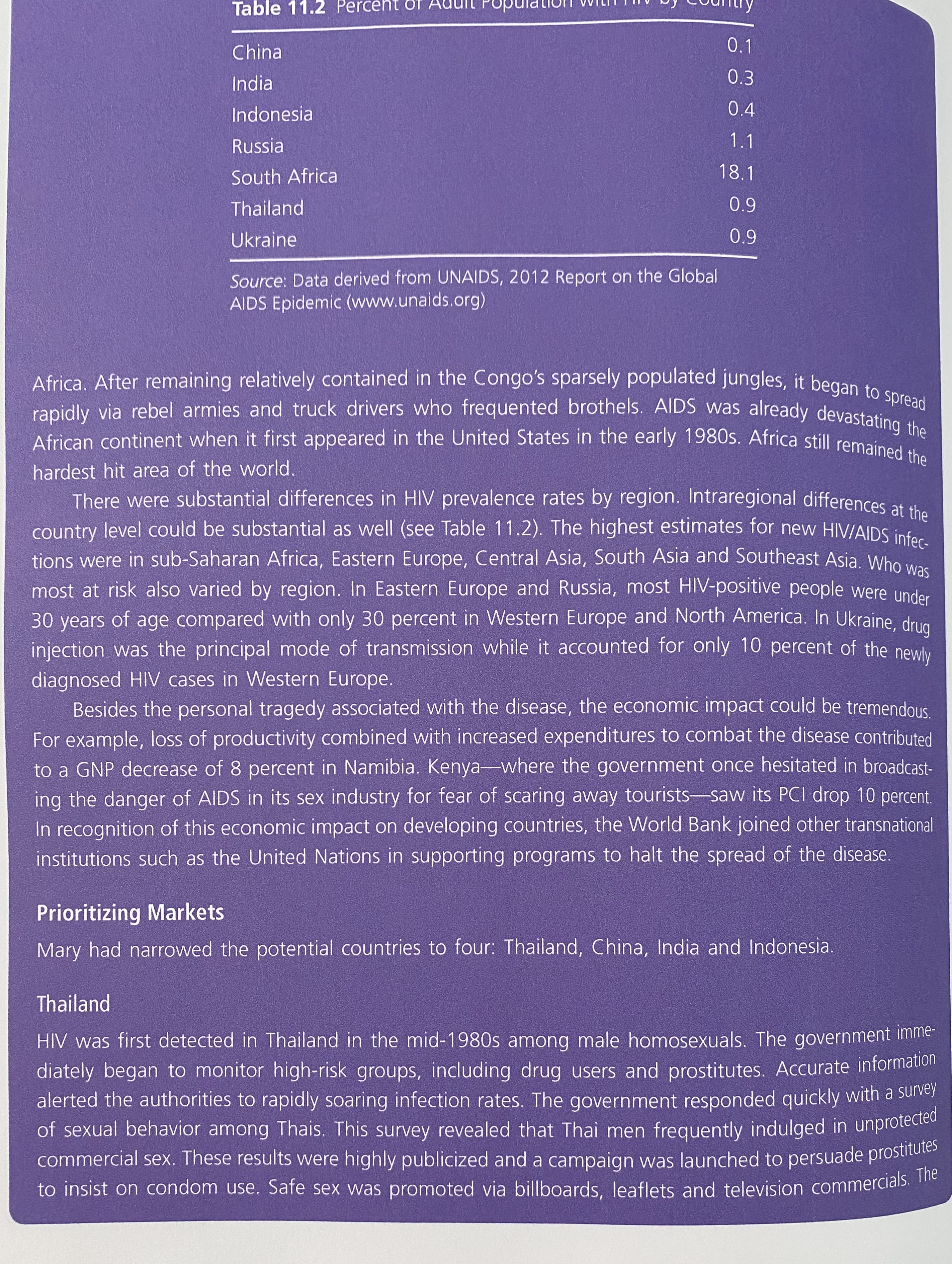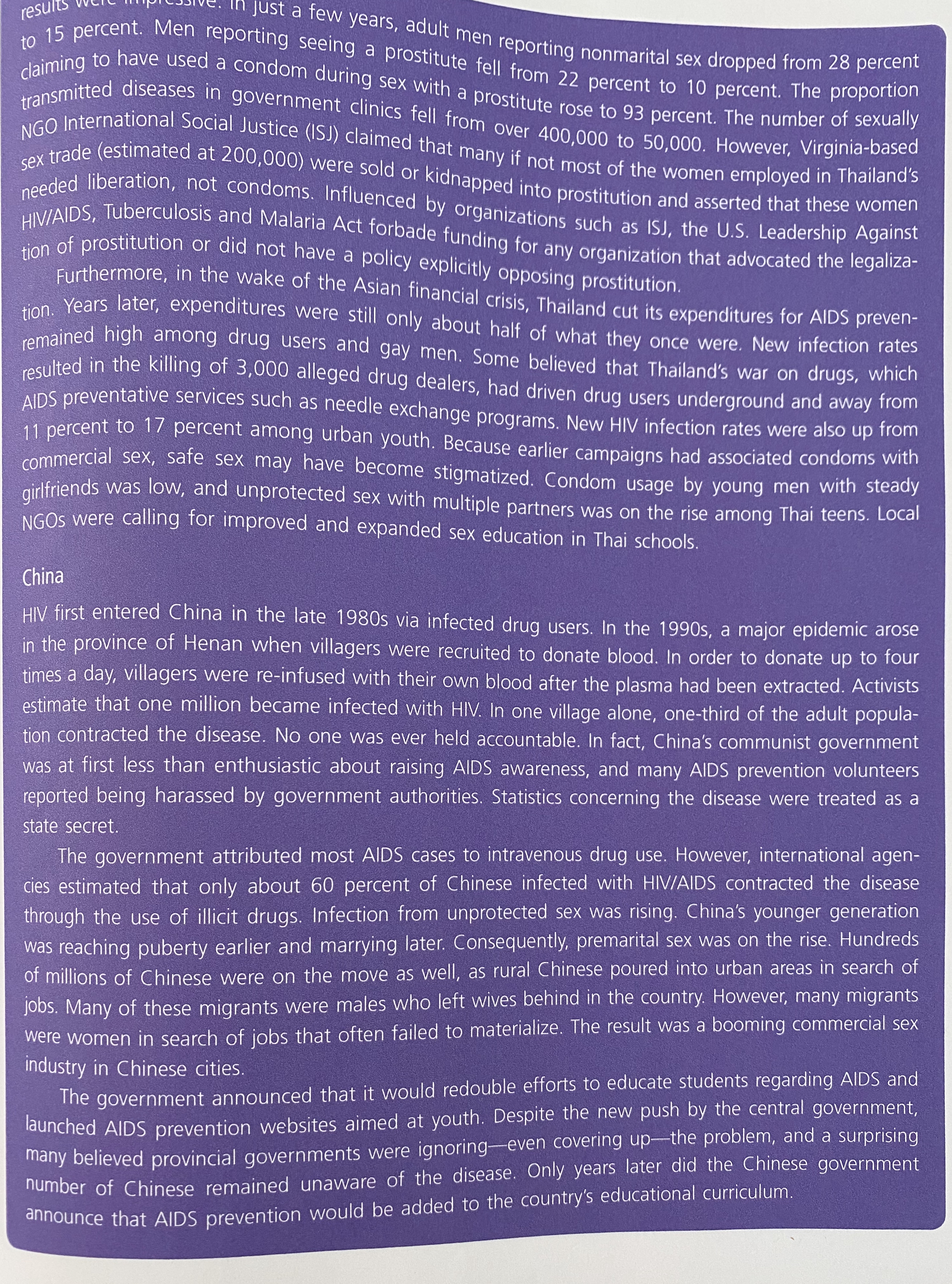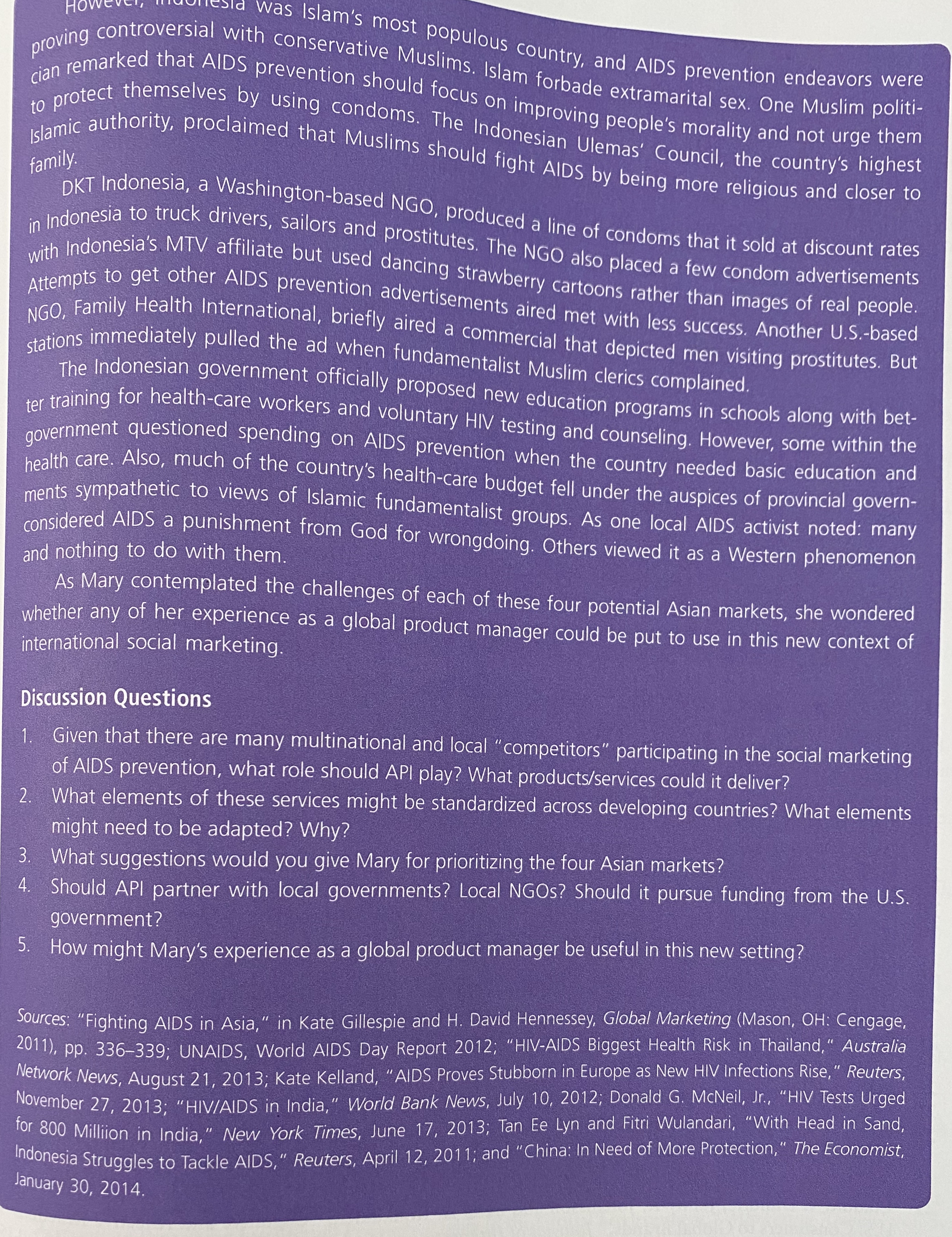Hi! I would love some help solving the Discussion questions at the end of this reading. #1-6. Thanks so much!
Table 11.2 Percent Of Adu China 0.1 India 0.3 Indonesia 0.4 Russia 1.1 South Africa 18.1 Thailand 0.9 Ukraine 0.9 Source: Data derived from UNAIDS, 2012 Report on the Global AIDS Epidemic (www.unaids.org) Africa. After remaining relatively contained in the Congo's sparsely populated jungles, it began to spread rapidly via rebel armies and truck drivers who frequented brothels. AIDS was already devastating the African continent when it first appeared in the United States in the early 1980s. Africa still remained the hardest hit area of the world. There were substantial differences in HIV prevalence rates by region. Intraregional differences at the country level could be substantial as well (see Table 11.2). The highest estimates for new HIV/AIDS infect tions were in sub-Saharan Africa, Eastern Europe, Central Asia, South Asia and Southeast Asia. Who was most at risk also varied by region. In Eastern Europe and Russia, most HIV-positive people were under 30 years of age compared with only 30 percent in Western Europe and North America. In Ukraine, drug injection was the principal mode of transmission while it accounted for only 10 percent of the newly diagnosed HIV cases in Western Europe. Besides the personal tragedy associated with the disease, the economic impact could be tremendous. For example, loss of productivity combined with increased expenditures to combat the disease contributed to a GNP decrease of 8 percent in Namibia. Kenya-where the government once hesitated in broadcast- ing the danger of AIDS in its sex industry for fear of scaring away tourists-saw its PCI drop 10 percent In recognition of this economic impact on developing countries, the World Bank joined other transnational institutions such as the United Nations in supporting programs to halt the spread of the disease. Prioritizing Markets Mary had narrowed the potential countries to four: Thailand, China, India and Indonesia. Thailand HIV was first detected in Thailand in the mid-1980s among male homosexuals. The government imme diately began to monitor high-risk groups, including drug users and prostitutes. Accurate information alerted the authorities to rapidly soaring infection rates. The government responded quickly with a survey of sexual behavior among Thais. This survey revealed that Thai men frequently indulged in unprotected commercial sex. These results were highly publicized and a campaign was launched to persuade prostitutes to insist on condom use. Safe sex was promoted via billboards, leaflets and television commercials. Theresults In) just a few years, adult men reporting nonmarital sex dropped from 28 percent 15 percent. Men reporting seeing a prostitute fell from 22 percent to 10 percent. The proportion "Aiming to have used a condom during sex with a prostitute rose to 93 percent. The number of sexually transmitted diseases in government clinics fell from over 400,090 to 50,000. However, Virginia-based NGO International Social Justice (IS)) claimed that many if not most of the women employed in Thailand's roy trade (estimated at 200,000) were sold or kidnapped into prostitution and asserted that these women needed liberation, not condoms. Influenced by organizations such as ISJ, the U.S. Leadership Against HIV/AIDS, Tuberculosis and Malaria Act forbade funding for any organization that advocated the legalliza- tion of prostitution or did not have a policy explicitly opposing prostitution. Furthermore, in the wake of the Asian financial crisis, Thailand cut its expenditures for AIDS prevent tion. Years later, expenditures were still only about half of what they once were. New infection rates remained high among drug users and gay men. Some believed that Thailand's war on drugs, which resulted in the killing of 3,000 alleged drug dealers, had driven drug users underground and away from AIDS preventative services such as needle exchange programs. New HIV infection rates were also up from 11 percent to 17 percent among urban youth. Because earlier campaigns had associated condoms with commercial sex, safe sex may have become stigmatized. Condom usage by young men with steady girlfriends was low, and unprotected sex with multiple partners was on the rise among Thai teens. Local NGOs were calling for improved and expanded sex education in Thai schools. China HIV first entered China in the late 1980s via infected drug users. In the 1990s, a major epidemic arose in the province of Henan when villagers were recruited to donate blood. In order to donate up to four times a day, villagers were re-infused with their own blood after the plasma had been extracted. Activists estimate that one million became infected with HIV. In one village alone, one-third of the adult popula- tion contracted the disease. No one was ever held accountable. In fact, China's communist government was at first less than enthusiastic about raising AIDS awareness, and many AIDS prevention volunteers eported being harassed by government authorities. Statistics concerning the disease were treated as a state secret. The government attributed most AIDS cases to intravenous drug use. However, international agen- cies estimated that only about 60 percent of Chinese infected with HIV/AIDS contracted the disease through the use of illicit drugs. Infection from unprotected sex was rising. China's younger generation was reaching puberty earlier and marrying later. Consequently, premarital sex was on the rise. Hundreds of millions of Chinese were on the move as well, as rural Chinese poured into urban areas in search of jobs. Many of these migrants were males who left wives behind in the country. However, many migrants were women in search of jobs that often failed to materialize. The result was a booming commercial sex industry in Chinese cities. The government announced that it would redouble efforts to educate students regarding AIDS and launched AIDS prevention websites aimed at youth. Despite the new push by the central government, many believed provincial governments were ignoring-even covering up-the problem, and a surprising number of Chinese remained unaware of the disease. Only years later did the Chinese government announce that AIDS prevention would be added to the country's educational curriculum.India "did, with an estimated 2.4 million infected with HIV, ranked third alter South Africa and Nigeria fo the highest number of infected persons. In recognition of this crisis, the government organized filamentary Forum on HIV/AIDS, which brought together more than 1,200 elected political figures from across the country. As in many developing countries, controversy surrounded AlDs statistics collected the government. To address this problem, the Indian government hired a prestigious (and independent private company to estimate the level of HIV/AIDS in India, Nonetheless, a government survey showed that prevention programs were only reaching about so percent of the population. Women who were infected by their husbands were often blamed by their in-laws. NGOs that operated homes for AIDS patients or AIDS orphans were often evicted if their land- ords discovered the nature of their operations. Police were even known to harass health workers who were trying to disseminate the government's own AIDS prevention information. Health workers in India believed that the disease was spreading fastest in rural areas where preven- tion programs were the weakest and record-keeping the worst. Hope Foundation was disseminating AIDS information and condoms at truck stops. India's five million truckers covered 5,000 miles of highways and reported three to five sexual partners a week. In six years, the HIV infection rate among truckers fell from 10 percent to 4 percent. To address the threat of AIDS to young people, the government had established two national prizes to award colleges or youth groups who acted as agents of change by implementing their own AIDS awareness initiatives. Still AIDS carried a social stigma in India. When the disease first entered the coun- try, many Indian officials declared that India's moral character and conservative sexual mores would prevent the spread of AIDS. Sex was rarely a subject of public discourse. It was largely absent from Indian films, and schools offered little or no sex education. Nonetheless, numerous NGOs operated in India. Their programs included support for persons with HIV, general awareness and educational programs and care for orphans whose parents died from AIDS. Funding came from federal and state governments, international donors and local contributions. One international donor, The Bill & Melinda Gates Foundation, pledged $100 million for a ten-year program for AIDS prevention in India. However, several years into the program, the Foundation decided to turn over its network of over 100 non-profit organizations to the Indian government to run. The government was unenthusiastic, noting that the costs of the network were astronomical. They pointed to air-conditioned clinics and glossy English posters and brochures that the clinics' illiterate clientele could not read. In addition, top managers were paid salaries commensurate with MBA salaries in the West. Results were disappointing as well. Despite an expensive campaign aimed at truckers, an internal report concluded that only 12 percent of truckers were even aware of the program's services and only 7 percent ever used them. Indonesia Indonesia historically enjoyed a low rate of HIV infection, but that was changing fast, particularly among drug users and throughout the nation's expanding commercial sex industry where only one man in ten used a condom. The WHO had given Indonesia an even higher priority for AIDS attention than China of Thailand, and international AIDS prevention groups stated that the Indonesian government vastly under- reported the cases in the country.HOW old Was islam's most populous country, and AIDS prevention endeavors were proving controversial with conservative Muslims. Islam forbade extramarital sex. One Muslim poll Pan remarked that AIDS prevention should focus on improving people's morality and not urge them protect themselves by using condoms. The Indonesian Ulemas' Council, the country's highest family. Jamic authority, proclaimed that Muslims should fight AIDS by being more religious and closer to DKT Indonesia, a Washington-based NGO, produced a line of condoms that it sold at discount rates in Indonesia to truck drivers, sailors and prostitutes. The NGO also placed a few condom advertisements with Indonesia's MTV affiliate but used dancing strawberry cartoons rather than images of real people. Attempts to get other AIDS prevention advertisements aired met with less success. Another U.S.-based NGO, Family Health International, briefly aired a commercial that depicted men visiting prostitutes. But stations immediately pulled the ad when fundamentalist Muslim clerics complained. The Indonesian government officially proposed new education programs in schools along with bet- ter training for health-care workers and voluntary HIV testing and counseling. However, some within the government questioned spending on AIDS prevention when the country needed basic education and health care. Also, much of the country's health-care budget fell under the auspices of provincial govern- ments sympathetic to views of Islamic fundamentalist groups. As one local AIDS activist noted: many considered AIDS a punishment from God for wrongdoing. Others viewed it as a Western phenomenon and nothing to do with them. As Mary contemplated the challenges of each of these four potential Asian markets, she wondered whether any of her experience as a global product manager could be put to use in this new context of international social marketing. Discussion Questions Given that there are many multinational and local " competitors" participating in the social marketing of AIDS prevention, what role should API play? What products/services could it deliver? 2. What elements of these services might be standardized across developing countries? What elements might need to be adapted? Why? 3. What suggestions would you give Mary for prioritizing the four Asian markets? 4. Should API partner with local governments? Local NGOs? Should it pursue funding from the U.S. government? 5 . How might Mary's experience as a global product manager be useful in this new setting? Sources: "Fighting AIDS in Asia," in Kate Gillespie and H. David Hennessey, Global Marketing (Mason, OH: Cengage, 2011), pp. 336-339; UNAIDS, World AIDS Day Report 2012; "HIV-AIDS Biggest Health Risk in Thailand," Australia Network News, August 21, 2013; Kate Kelland, " AIDS Proves Stubborn in Europe as New HIV Infections Rise, " Reuters, November 27, 2013; "HIV/AIDS in India," World Bank News, July 10, 2012; Donald G. McNeil, Jr., "HIV Tests Urged for 800 Million in India," New York Times, June 17, 2013; Tan Ee Lyn and Fitri Wulandari, "With Head in Sand, indonesia Struggles to Tackle AIDS," Reuters, April 12, 2011; and "China: In Need of More Protection," The Economist, January 30, 2014










